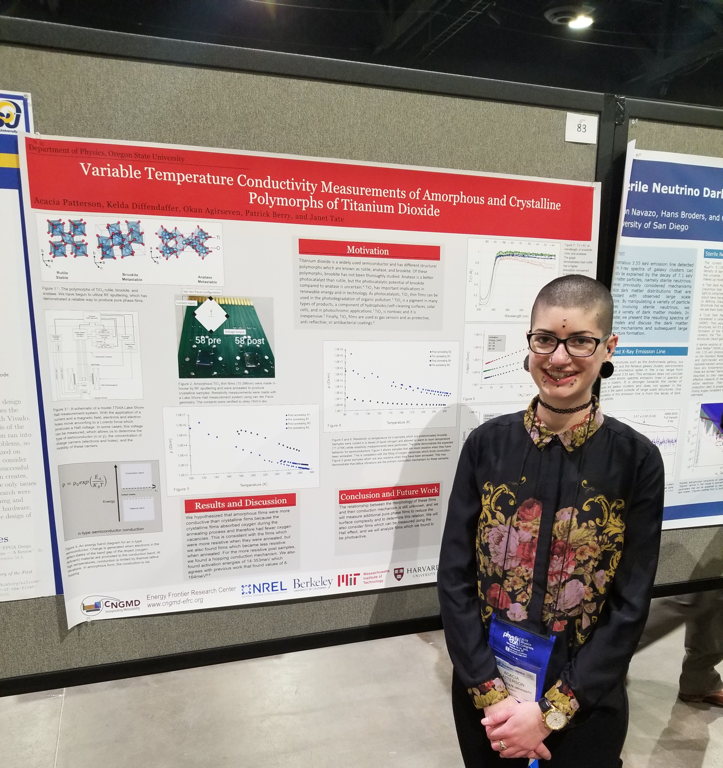OSU Physics undergraduates were busy in research labs all over the U.S. and the world during the summer of 2017. Many of them had National Science Foundation Research Experience for Undergraduates (NSF-REU) positions, others were working in laboratories in REU programs sponsored by other agencies, and some had industrial internships. All of them helped create new knowledge and they all had a wonderful time doing research!
This level of participation in cutting-edge research by OSU undergraduates is very impressive – congratulations to all of you! Some of this work will be presented at seminars in the Physics Department during the year, so there will be an opportunity for the younger students to learn about the process and the fun of working in a research environment.
Yousif Almulla participated in an REU program at Oak Ridge National Laboratory with Dr. Jacek Jakowski. He used density functional theory to understand how qubits work.
Hassan Alnatah developed a protocol with Dr. Bo Sun of OSU Physics to construct a 3D printed cell model based on confocal imaging.
Hazel Betz did an internship in the Fault Isolation and Failure Analysis Laboratory at Intel in Hillsboro, OR. She analyzed samples with a scanning electron microscope and designed to proof-of-concept experiments to improve device probing characteristics, and developed and documented procedures to improve the process.
Mirek Brandt received a fellowship to study at the Kupcinet-Getz International Science Summer School at the Weizmann Institute in Israel. During his 8 weeks with Dr. Boaz Katz, he modeled the spectrum of type 1a supernova, given some arbitrary explosion model. The intent is to eventually test the supernova detonation models studied by Dr. Katz. Mirek highly recommends the program! Mirek then returned to OSU to take up his Goldwater Fellowship in the lab of Dr. Matt Graham of Physics. A very busy summer!
Katelyn Chase participated in an NSF-REU program at the University of Utah in the group of Dr. Michael Vershinin in the Physics and Astronomy department. She studied the effect of Trimethylamine N-oxide (TMAO) on the stability of kinesin-1 motor proteins as a function of temperature.
Aaron Dethlefs worked in Dr. Janet Tate’s OSU lab commissioning the new PPMS system in EECS for transport experiments on semiconductors.
Patrick Flynn solved partial differential equations with applications to bacteria migration, with Dr. Arnd Scheel in the Math Department at the University of Minnesota.
Ian Founds studied students’ use of the chain rule in thermodynamics with Dr. Paul Emigh and Dr. Corinne Manogue of the OSU Physics Physics Education Research group. Ian presented his work at the PERC conference this summer.
Cassandra Hatcher had a SURE Science Fellowship to work with Dr. Davide Lazzati of OSU Physics. She studied X-ray polarization from Compton scattering in asymmetric supernova remnants.
Garrett Jepson worked in Dr. David Roundy’s group in the OSU Physics Department. He evaluated a new Monte Carlo code written in rust for use in studying fluids. He also worked with Dr. Guenter Schneider of OSU Physics using machine learning techniques to locate and identify cells in a cell microscopy image. He has a SURE Science award to support his work.
Ryan Lance developed a new analysis for optical spectroscopy of thin films in Dr. Janet Tate’s lab in the OSU Physics Department. He received an honorable mention for his presentation at OSU’s Summer Undergraduate Research Conference. Ryan shows his award in the picture below.

Chris May, working in Dr. David Roundy’s group, developed an improved code for studying the Weeks-Chandler-Anderson fluid.
Dublin Nichols is an OSU College of Science SURE Science fellow and this summer, he built a microscope rig that enabled him to stack atomically thin crystals for further study. He worked in the lab of Dr. Ethan Minot of OSU Physics.
Gabriel Nowak had a Science Undergraduate Laboratory Internship (SULI) in the Atomic, Molecular, and Optical sciences group in the Chemical Sciences Division at Lawrence Berkeley National Laboratory (LBNL). He investigated laser-generated nanoparticle array formation and the dynamics of charge transfer in the process.
Jesse Rodriguez modeled plasmas in the lab of Dr. Mark Cappelli of Stanford’s Mechanical Engineering Department.
Nikita Rozanov characterized the interaction between cytochrome c and 3-mercaptopropionoic acid (MPA) coated gold nanoparticles using molecular dynamics simulations. He worked under the supervision of research scientist Dr. Caley Allen in the group of Dr Rigoberto Hernandez at the Johns Hopkins Department of Chemistry. This work was part of an NSF-REU at the Center for Sustainable Nanotechnology.
Tanner Simpson worked in Dr. David Roundy’s group testing broad histogram Monte Carlo methods using the square well fluid. He presented his work at OSU’s Summer Undergraduate Research Symposium.
Abe Teklu was part of a DOE-funded program at General Atomics in San Diego with mentor Dr. Richard Moyer. Abe analyzed divertor footprints in the DIII-D tokamak to determine whether computational models describe the divertor region accurately. Here are pictures of Abe discussing his results at a poster session (below left, the taller person) and gathering data in the tokomak (below right, the person in the back row).


Attila Varga had a SURE Science fellowship to work with Dr. Kathy Hadley of OSU Physics on modeling rotating star-disk systems.
John Waczak tested and developed a model for the dynein motor protein worked in Dr. David Roundy’s group.
Physics faculty also worked with students from other disciplines. Dr. Weihong Qui and Dr. Bo Sun, who both study biological physics, hosted SURE Science scholars Youngmin Park (BB) and Theresa Dinh (Biology) in their labs this summer.











